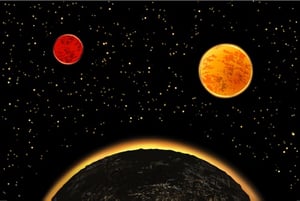 Johannes Kepler (1571–1630) was, to say the least, a pretty smart guy... in fact, some say he was almost as smart as me. Without the aid of even a dollar-store calculator, he established the physical laws that describe the motion of planets through the heavens. His work predated and inspired Isaac Newton’s development of the theory of universal gravitation.
Johannes Kepler (1571–1630) was, to say the least, a pretty smart guy... in fact, some say he was almost as smart as me. Without the aid of even a dollar-store calculator, he established the physical laws that describe the motion of planets through the heavens. His work predated and inspired Isaac Newton’s development of the theory of universal gravitation.
It’s therefore only fitting that Kepler’s name is attached to the NASA spacecraft whose sole purpose is to find planets outside our solar system. Since its launch in 2009, data from Kepler has helped scientists to identify over 1,000 planets (called exoplanets) orbiting stars far off in the Milky Way galaxy. This past week, the Kepler telescope's successor TESS was launched, ready to pick up even more data, including the possibility of directly imaging (!!!!) of exoplanets.
How to Find an Exoplanet
The concept behind finding exoplanets is simple: Take a picture of a particular patch of sky every 30 minutes for several years, and check for changes in the brightness of each star. Periodic dips in brightness may mean that a planet is passing in front of the star, blocking some of its light. Do some further analysis to ensure it’s not the result of instrument noise, binary stars, or other sources of error, and voilà—you’ve found an exoplanet. (Sadly, unlike with comets, you don’t get to name it after yourself.) The data can even help identify whether it’s rocky or gaseous, the approximate surface temperature, and how long it takes to orbit around its star.
In practice, it’s not that simple—it’s been compared to finding a firefly next to a searchlight from thousands of miles away. The main problem lies in the amount of data that must be processed. Kepler has observed over 200,000 stars. There's tons of data to sift through. And each potential exoplanet exhibits different data characteristics—there’s no single pattern that says “here’s a planet.”
It’s exactly the sort of thing that artificial neural networks are really good at.
Google’s AI Exoplanet Finder
Last year, Chris Shallue, an artificial intelligence (AI) researcher at Google, collaborated with University of Texas at Austin astrophysicist Andrew Vanderburg to develop an AI-based tool to help find likely exoplanets in the Kepler data. They designed a machine learning model for the task in TensorFlow and trained it using Kepler data for confirmed exoplanets (as well as data confirmed not to indicate any exoplanets). In the process, the system learned to distinguish data patterns caused by planets from similar patterns caused by other things, such as normal instrument noise.
The team then tested the system using known data it had never encountered before. The system correctly distinguished planets from non-planets 96 percent of the time.
After the testing, they set their system to work on Kepler data from 670 stars for which previous research had already found at least one exoplanet. The system discovered two new exoplanets, one of which (known as Kepler 90i) brought its solar system’s planet total to eight—as many as are known to be in our own solar system, and the most exoplanets ever to be found orbiting a single star.
Shallue and Vanderburg have made their model available for others to use on Kepler data. Similar machine-learning models could be brought to bear on data from other instruments, both space- and Earth-based, in the search for exoplanets.
Where to From Here?
From the exoplanets discovered so far, about one in five of the stars examined have Earth-like planets orbiting in the “habitable zone,” meaning the right distance from the star to support life. By extrapolating the data, scientists estimate there may be 11 billion planets in our galaxy alone that have conditions to support life in some form. And that’s to say nothing of the millions of other galaxies populating the universe. That’s a lot of potential vacation spots.
However, there are some things that the Kepler data can’t tell us, such as whether a given exoplanet has a protective atmosphere like ours, water oceans, or a tilted axis that causes seasons. And of course, Kepler can’t tell us if any of these faraway planets are inhabited.
Could machine learning be used to discover life on other planets? Probably not using the exoplanet data we have today. But there are other large data sets from various astronomical instruments, such as radio telescopes, in which evidence of extraterrestrial life may be hiding. If we can train a machine learning system on what to look for in the data, we might be in for some interesting discoveries.
















